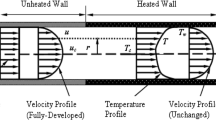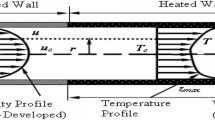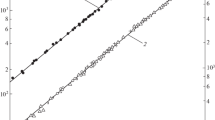Abstract
This paper presents a finite element-based model for the prediction of 2-D and 3-D internal flow problems. The Eulerian velocity correction method is used which can render a fast finite element code comparable with the finite difference methods. Nine different models for turbulent flows are incorporated in the code. A modified wall function approach for solving the energy equation with high Reynolds number models is presented for the first time. This is an extension of the wall function approach of Benim and Zinser and the method is insensitive to initial approximation. The performance of the nine turbulent models is evaluated by solving flow through pipes. The code is used to predict various internal flows such as flow in the diffuser and flow in a ribbed channel. The same Eulerian velocity correction method is extended to predict the 3-D laminar flows in various ducts. The steady state results have been compared with benchmark solutions and the agreement appears to be good.
Similar content being viewed by others
References
Acharya S, Dutta S, Myrum A, Baker R S 1993 Periodically developed flow and heat transfer in a ribbed duct.Int. J. Heat Mass Transfer 36: 2069–2082
Autret A, Grandotto M, Dekeyser I 1987 Finite element computation of a turbulent flow over a two dimensional backward facing step.Int. J. Numer. Methods Fluids 7: 89–102
Benim A C, Zinser W 1985 Investigation into the finite element analysis of confined turbulent flows using ak-ε model.Comput. Methods Appl. Mech. 51: 507–523
Bradshaw Pet al 1981Engineering calculation methods for turbulent flows (London: Academic Press)
Caretto L Set al 1972 Two numerical methods for 3-D boundary layers.Comput. Methods Appl. Mech. Eng. 1: 39–57
Chitambaran V C 1978Some studies on the structure of incompressible turbulent flow in a two-dimensional diffuser with inlet velocity distortions, Ph D thesis, Indian Institute of Technology, Madras
Curr R M, Sharma D, Tatchell 1972 Numerical predictions of some 3-D boundary layers in ductsComput.Methods Appl. Mech. Eng. 1: 143–158
Deissler R G 1988 Turbulent solutions of the Navier-Stokes equations.Encyclopedia of fluid mechanics (Houston,TX: Gulf) vol. 6, chap. 29
Donea J, Ginliani S, Laval H, Quartapele 1982 Finite element solution of unsteady Navier-Stokes equations by fractional step method.Comput. Methods Appl. Mech. Eng. 30: 53–73
Ferziger J H 1987 Simulation of incompressible turbulent flows.J. Comput. Phys. 69: 1–48
Gresho P M, Sani R L 1987 On pressure boundary conditions for the incompressible Navier-Stokes equations.Int. J. Numer. Methods Fluids 7: 1111–1145
Gresho P Met al 1981 Solution of the time dependent 3-D incompressible Navier-Stokes equation viaFEM. InProc. Int. Conf. on Numerical Methods in Laminar and Turbulent flows (eds) C Tayloret al, UK
Godbole P N 1975 Creeping flow in rectangular ducts by finite element method.Int. J. Numer. Methods Eng. 727–731
Hah C 1983 Calculation of various diffuser flows with inlet swirl and inlet distortions effects.AIAA J. 21: 1127–1133
Haines A B 1982 Turbulence modelling — Report of a working party.Aeronaut. J. 86: 269–277
Han J C, Glicksman L R, Roshenow W M 1978 An investigation of heat transfer and friction factor for rib roughened surface.Int. J. Heat Mass Transfer 27: 1143–1155
Hoffmann J A 1982 Effects of free stream turbulence on diffuser performance.J. Fluids Eng., ASME 103: 104–110
Hussaini M Y, Zang T A 1987 Spectral methods in fluid dynamics.Annu. Rev. Fluid Mech. 19: 339–367
Hutton A G, Smith R M 1987 The computation of turbulent flows of industrial complexity by finite element method — Progress and prospects. InFinite elements in fluids (eds) R H Gallagheret al (New York: John Wiley) 7: 289–310
Johnson R W, Launder B E 1982 Discussions on the calculation of turbulent heat transport down stream of an abrupt pipe expansion.Numer. Heat Transfer 5: 493–495
Lakshminarayana B, Kirtley K R, Warfield M 1989 Computational techniques and validation of 3-dimensional viscous turbulent codes for internal flows.Sādhanā 14: 59–91
Lam C K G, Bremhorst K 1981 A modified form ofk −ε model for predicting wall turbulence.J. Fluids Eng. 103: 456–460
Launder B E 1982 A generalized algebraic stress transport modelling.AIAA J. 20: 436–437
Launder B E 1984 Numerical computation of convective heat transfer in complex turbulent flows: Time to abandon wall functions.Int. J. Heat Mass Transfer 27: 1485–1491
Launder B E 1988 On the computation of convective heat transfer in complex turbulent flow.J. Heat Transfer 110, 1112–1128
Liou T M, Chang Y, Huang D W 1990 Experimental and computational study of turbulent flows in a channel with two pairs of turbulence promoters in tandem.J. Fluids Eng. 112: 302–310
Lumley J L 1983 Turbulence modelling.ASME J. Appl. Mech. 50: 1097–1103
Markatos M C 1988 Computer simulation techniques for turbulent flows. InEncyclopedia of fluid mechanics (Houston,TX: Gulf) vol. 6, chap. 28
Martinuzzi R, Pollard A 1989 Comparative study of turbulence models in predicting turbulent pipe flow. Part I: Algebraic stress andk −ε models.AIAA J. 27: 29–36
Mellor G L, Herring J H 1973 A survey of mean turbulent filled closure models.AIAA J. 11: 590–599
Michelic M, Wingerath K 1988 Numerical solution of free and forced convection bulk flows. InEncyclopedia of fluid mechanics (Houston,TX: Gulf) vol. 6, chap. 35
Morgan Ket al 1987 Investigation of mixing length and two-equation turbulence models utilizing the finite element method.Appl. Math. Modelling 1: 395–400
Murphy J D 1988 Turbulence modelling. InEncyclopedia of fluid mechanics (USA: Gulf) vol. 6, chap. 28
Nallasamy M 1987 Turbulence models and their applications to the prediction of internal flows: A review.Comput. Fluids 15: 151–194
Nonino C, Del Guidice, Comini G 1988 Laminar forced convection in 3-D duct flows.Numer. Heat Transfer 13: 451–466
Patankar S V 1988 Recent developments in computational heat transfer.ASME J. Heat Transfer 110: 1037–1045
Pletcher R H 1988 Progress in turbulent forced convection.ASME J. Heat Transfer 110: 1129–1144
Rabas T J 1989 Selection of energy efficient enhancement geometry for single phase turbulent flows inside tubes.ASME Proc. of 1989 Natl. Heat Conf., HTD vol. 108, pp. 193–204
Ravikumaur S G 1988Finite element analysis of convective heat transfer and heat exchangers. Ph D thesis, Indian Institute of Technology, Madras
Ravisankar M S 1992Finite element analysis of turbulent flows with heat transfer. M S thesis, Indian Institute of Technology, Madras
Reddy J N 1982 Penalty finite element analysis of 3-D Navier-Stokes equations.Comput. Methods Appl. Mech. Eng. 35: 87–106
Reynolds W C 1978 On calculation of turbulent flows. InTurbulence (ed.) P Bradshaw (New York: Springer-Verlag) chap. 5
Rodi W 1982 Examples of turbulent flow in smooth pipe.Appl. Sci. Res. 28: 872–879
Rodi W 1984 Turbulence models and their applications to hydraulics — State of art review.Intl. Assos. Hydraulic Res., Delft
Shah R K, London A L 1978 Laminar flow forced convection in ducts.Advances in heat transfer: Supplement 1 (New York: Academic Press)
Shih T M 1985 A literature survey on numerical heat transfer.Numer. Heat Transfer 8: 1–24
Shih T M 1987 A literature survey on numerical heat transfer.Numer. Heat Transfer 11: 1–29
Shih T M 1989 A literature survey on numerical heat transfer.Numer. Heat Transfer 15: 1–39
Smith R M 1984 A practical method of two-equation modelling using finite elements.Int. J. Numer. Methods Fluids 4: 321–336
Srinivas M 1994Finite element analysis of internal flows with heat transfer. Ph D thesis, Indian Institute of Technology Madras
Taylor Cet al 1977 A numerical analysis of turbulent flow in pipes.Comput. Fluids 5: 191–203
Taylor C, Harper J J, Hughes T G, Morgan K 1981 An analysis of developing turbulent flow in a circular pipe by the finite element method. InProc. Numer. Methods Laminar and Turbulent flows (eds) Bakeret al (Swansea: Pineridge)
Utnes T 1988 Two-equation (k-ε) turbulence computations by the use of a finite element model.Int. J. Numer. Methods Fluids 8: 965–975
Author information
Authors and Affiliations
Rights and permissions
About this article
Cite this article
Srinivas, M., Ravisankar, M.S., Seetharamu, K.N. et al. Finite element analysis of internal flows with heat transfer. Sadhana 19, 785–816 (1994). https://doi.org/10.1007/BF02744405
Issue Date:
DOI: https://doi.org/10.1007/BF02744405




